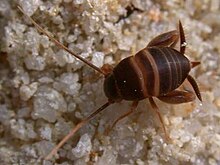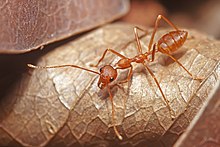Ant mimicry

Bottom: An ant-mimicking spider, Myrmarachne
Ant mimicry or myrmecomorphy is
In myrmecophily, mimic and model live commensally together; in the case of ants, the mimic is an inquiline in the ants' nest. Such mimics may in addition be Batesian or aggressive mimics. To overcome ants' powerful defences, mimics may imitate ants chemically with ant-like pheromones, visually, or by imitating an ant's surface microstructure to defeat the ants' tactile inspections.
Types
Batesian mimicry

-
Batesian mimicry versus myrmecophily as other species mimic ants
Over 300 spider species mimic the social behaviours, morphological features and predatory behaviour of ants. Many genera of jumping spiders (Salticidae) mimic ants.[5] Jumping spiders in the genus Myrmarachne are Batesian mimics which resemble the morphological and behavioural properties of ants to near perfection. These spiders mimic the behavioural features of ants such as adopting their zig-zag locomotion pattern.[6] Further, they create an antennal illusion by waving their first or second pair of legs in the air. The slender bodies of these spiders make them more agile, allowing them to easily escape from predators. Studies on this genus have revealed that the major selection force is the avoidance of ants by predators such as spider wasps and other larger jumping spiders.[7][8][9] Ant mimicry has a cost, given the body plan of spiders: the body of spider myrmecomorphs is much narrower than non-mimics, reducing the number of eggs per eggsac, compared to non-mimetic spiders of similar size. They seem to compensate by laying more eggsacs over their lifetimes.[8] A study of three species of mantises suggested that they innately avoided ants as prey, and that this aversion extends to ant-mimicking jumping spiders.[10]
- Some of the many jumping spiders that are Batesian mimics of ants
Batesian mimicry of ants appears to have evolved even in certain plants, as a visual anti-herbivory strategy.[11] Passiflora flowers of at least 22 species, such as P. incarnata, have dark dots and stripes on their flowers for this purpose.[12]
-
It has been suggested that the elongated spots on the reproductive organs of Passiflora incarnata and related species are ant-mimicking to deter herbivores.[12]
Myrmecophily

Some arthropods are
The cricket
Mites are among the most speciose mimics of ants, and can occur in large numbers in an ant colony. A single colony of Eciton burchellii army ants may contain some 20,000 inquiline mites.[14] The phoretic mite Planodiscus (Uropodidae) attaches itself to the tibia of its host ant, Eciton hamatum. The cuticular sculpturing of the mite's body as seen under the electron microscope strongly resembles the sculpturing of the ant's leg, as do the arrangements and number of the bristles (setae). Presumably, the effect is that when the ant grooms its leg, the tactile sensation is as it would be in mite-free grooming.[16]
The snail Allopeas myrmekophilos lives in army ant colonies.[17]
Lycaenid butterflies

Some 75% of
Parasitoid wasps
The parasitoid wasp
-
Model:Lasius niger
Aggressive mimicry
-
Aggressive mimicry of ants by spiders. The ant is both the model and the dupe, and it becomes the spider's prey.
-
Aggressive mimic with model/dupe/prey:
Myrmarachne spider eating a queen ant -
Both aggressive and Batesian mimicry:
Aphantochilus rogersi
-
Model: Red weaver ant,
Oecophylla smaragdina -
Mimic: FemaleMyrmarachne plataleoidesresembles worker red weaver ant.
-
Mimic: Male M. plataleoides resembles one red weaver ant worker carrying another.
Special protection for young insects
Multiple groups of insects have evolved ant mimicry for their young, while their adults are protected in different ways, either being
The young instars of some mantids, such as Odontomantis pulchra[28] and Tarachodes afzelii are Batesian mimics of ants. Bigger instars and adults of these mantids are not ant mimics, but are well-camouflaged predators, and in the case of Tarachodes, that eat ants.[29]
Young
The phasmid Extatosoma tiaratum, resembling dried thorny leaves as an adult, hatches from the egg as a replica of a Leptomyrmex ant, with a red head and black body. The long end is curled to make the body shape appear ant-like, and the movement is erratic, while the adults move differently, if at all. In some species the eggs resemble ant-dispersed (myrmecochoric) plant seeds, complete with a mimic oil body (a "capitulum"). These eggs are collected by the ants, deceived in a different way, and taken to their nests. The capitulum is removed and eaten, leaving the eggs viable.[27]
-
Phasmid Extatosoma tiaratum adult is a well-camouflagedplant mimic.
-
Extatosoma tiaratum eggs, mimicking ant-dispersed (myrmecochoric) plant seeds; ants bring these to their nests, eating the projecting mimic oil body, leaving the eggs viable.
-
Freshly hatched Extatosoma tiaratum nymph mimics Leptomyrmex ants.
Taxonomic range
Ant mimicry has a wide taxonomic range, including some 2000
| Eukaryotes |
| ||||||||||||
References
- ^ ISBN 978-0-007-29899-0.
- ^ ISBN 978-0-8014-3655-0.
- ^ a b Viegas, Jennifer (15 November 2014). "More Than 300 Spiders Pretend to be Ants". Discovery. Archived from the original on 2 December 2014.
- doi:10.11646/zootaxa.1996.1.1.Lund) that often occur on the same leaf surfaces. They resemble ants in movement, size and shape (with the latter similarity enhanced by wing pigmentation), and can be difficult to distinguish from ants until they take flight.
As noted by Papavero (1964), syringogastrids walking on leaves are strikingly similar to ants (especially Pseudomyrmex
- PMID 34102888.
- PMID 28701553.
- ^ PMID 20961898.
- ^ JSTOR 3495552.
- S2CID 11200771.
- hdl:10092/17559.
- ^ Weins, D. (1978). "Mimicry in plants". Evolutionary Biology. 11: 365–403.
- ^ a b c Lev-Yadun, Simcha (2009). "Ant mimicry by Passiflora Flowers?". Israel Journal of Entomology. 39: 159–163.
- ^ ISSN 0066-4170.
- ^ PMID 21419982.
- ^ Osservazioni sopra la Blarta acervorum di panzee. Gryllus Myrmocophilus nob. Memoria (inedita) del dott. Paolo Savi, con tavola in rame, Biblioteca Italiana ossia Giornale di letteratura scienze ed arti (1819), Volume 15, Fascicolo
- ^ ISBN 978-0-674-04075-5.
- .
- ProQuest 222345887.
- JSTOR 24939256.
- ^ .
- ^ PMC 1690087.
- ^ PMID 25622726.
- ^ Lorenzi, C.; Bagnères, A. G.; Clement, J. L. (1996). "The role of cuticular hydrocarbons in social insects: is it the same in paper-wasps". In Turillazzi, S.; West-Eberhard, M.J. (eds.). Natural History and Evolution of Paper Wasps. Oxford University Press. pp. 178–189.
- .
- ^ Murphy, Frances & Murphy, John (2000): "An Introduction to the Spiders of South East Asia". Malaysian Nature Society, Kuala Lumpur. Page 303
- .
- ^ .
- .
- ^ ISBN 978-0-8018-6174-1.
- ^ ISBN 978-1-4443-1767-1.
- .
- .
- S2CID 84201196.





![It has been suggested that the elongated spots on the reproductive organs of Passiflora incarnata and related species are ant-mimicking to deter herbivores.[12]](http://upload.wikimedia.org/wikipedia/commons/thumb/d/d1/Passiflora_incarnata_%28detail%29.jpg/415px-Passiflora_incarnata_%28detail%29.jpg)




















